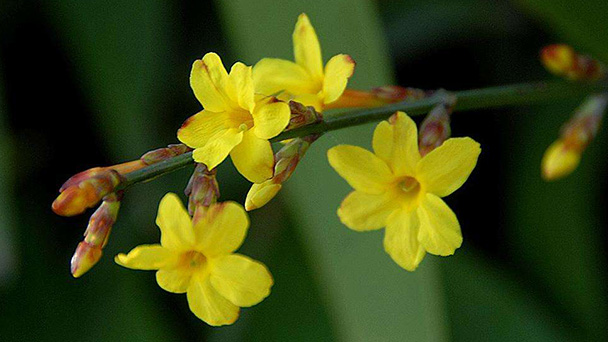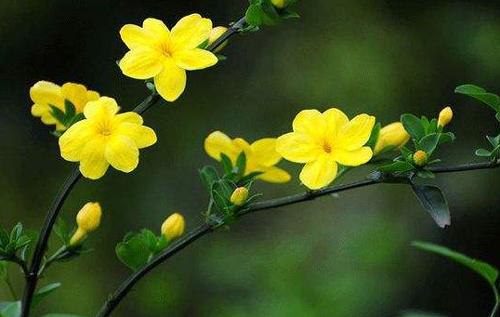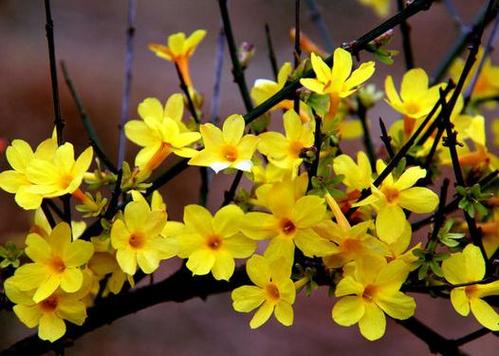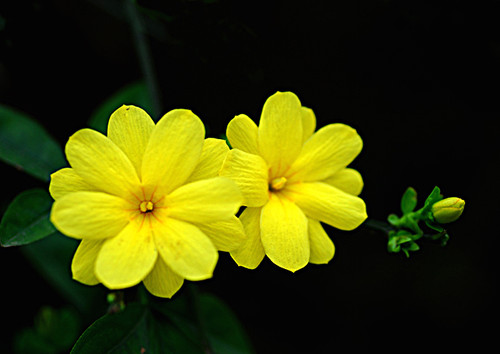Jasminum nudiflorum Lindl. profile
Written by Maggie
Dec 08 2020

Jasminum nudiflorum Lindl.'plant height is 30-500 cm. The branchlets are slender and erect or arched and drooping, and are draped. It has 3 leaflets and compound leaves are alternately opposite, the leaves being ovate to oblong. The flower grows solitarily on the branches that were born last year. It opens before the leaves. It has a delicate fragrance and golden yellow color. It is named because it blooms first among the hundreds of flowers, and the spring when the flowers bloom all the time.
Jasminum nudiflorum Lindl. is one of the common flowers in China. Jasminum nudiflorum Lindl. is not only dignified and beautiful, but also has extraordinary temperament. It has the characteristics of not being afraid of the cold, regardless of the terroir, and strong adaptability. It has always been loved by people. Jasminum nudiflorum Lindl. has a history of more than 1,000 years of cultivation, and it is now the city flower of Hebi City, Henan Province.
Jasminum nudiflorum Lindl. picture

Morphological characteristics of Jasminum nudiflorum Lindl.
Jasminum nudiflorum Lindl. is a deciduous shrub, standing or creeping, 0.3-5 meters high, with drooping branches. The branches are slightly twisted, smooth and glabrous, and the branchlets are quadrangular with narrow wings.
Jasminum nudiflorum Lindl's leaves are opposite, three compound leaves, branchlets is often with simple leaves at the base; leaf shafts with narrow wings, petioles 3-10 mm long, glabrous; leaf blades and leaflets are slightly hairy on both sides when young, and only leaf margins have eyelashes when old Leaflets ovate, long ovate or elliptic, narrowly elliptic, sparsely obovate, apex acute or obtuse, short pointed, base wedge, leaf margin recurved, midvein slightly concave on top and convex below, Lateral veins are not obvious; the terminal leaflets are larger, 1-3 cm long, 0.3-1.1 cm wide, sessile or the base extends into a short stalk, lateral leaflets 0.6-2.3 cm long, 0.2-11 cm wide, none Stem; single leaf is oval or elliptical, sometimes nearly round, 0.7-2.2 cm long and 0.4-1.3 cm wide.
Jasminum nudiflorum Lindl's flowers are solitary in the leaf axils of last-born branchlets, sparsely at the top of branchlets; bracts are leaflet-shaped, lanceolate, ovate or elliptical, 3-8 mm long and 1.5-4 mm wide; pedicels are 2-3 mm long; Calyx green, lobes 5-6, narrow lanceolate, 4-6 mm long, 1.5-2.5 mm wide, apex acute; corolla yellow, 2-2.5 cm diameter, corolla tube length 0.8-2 cm, base diameter 1.5 -2 mm, gradually expanding upward, 5-6 lobes, oblong or elliptical, 0.8-1.3 cm long, 3-6 mm wide, sharp or obtuse at the apex. Flowering from February to April
Growth habits of Jasminum nudiflorum Lindl.
Jasminum nudiflorum Lindl. likes light, which is slightly shade-tolerant, slightly cold-resistant, and afraid of waterlogging. It can live through the winter in North China and Yanling. It requires a warm and humid climate, loose, fertile and well-drained sandy soil, and thrive in acid soil. Poor growth in alkaline soil. Strong root germination. The ground part of the branches is easy to root.
Geographical distribution of Jasminum nudiflorum Lindl.
Jasminum nudiflorum Lindl is produced in China's Gansu, Shaanxi, Sichuan, northwestern Yunnan, and southeastern Tibet. In the bushes on the green hillside, the altitude is 800-2 000 meters. It is commonly cultivated in China and around the world.
The breeding method of Jasminum nudiflorum Lindl.
Jasminum nudiflorum Lindl. is mainly cuttings, and can also be reproduced by layering and ramets. Cuttings: Spring, summer, and autumn can be carried out. Cut semi-ligninized branches 12-15 cm long, insert them into sandy soil, keep moist, and take root in about 15 days. Layering: Shallowly bury the longer branches in sand, without scratching, take root after 40-50 days, and separate and transplant from the mother plant in the following spring. Rectification: Can be carried out when buds germinate in spring. When transplanting in spring, part of the above-ground branches and trunks should be cut off, and the soil should be brought with them. Dry cuttings can also be used, that is, after cutting in a well-built seedbed, and water is irrigated. Cuttings can be carried out from mid-October to mid-November or in spring. After rooting, it can be planted separately, and it can also be ramified or layered for reproduction.

Cultivation techniques of Jasminum nudiflorum Lindl.
Pick
Cuttings can be carried out in spring, summer, and autumn. Cut semi-lignified branches 12-15 cm long, insert them into sandy soil, keep them moist, and take about 15 days to root. The longer branches of Jasminum nudiflorum Lindl. are shallowly buried in sand, without scratching, they take root after 40-50 days, and they are separated and transplanted from the mother plant in the following spring.
Ramets
It can be done in spring when the buds of Jasminum nudiflorum Lindl. are sprouting. When transplanting in spring, part of the above-ground branches and trunks should be cut off, and the soil should be brought with them. During the growth process, pay attention to the soil not being able to accumulate water and excessive drought, and properly fertilize 2-3 times before and after flowering. Pruning and shaping should be done in autumn and winter to keep many new flowers.
Short cut
Jasminum nudiflorum Lindl. forms flower buds on the 1-year-old branches and blooms in the second year from late winter to spring. Therefore, all flowering branches should be cut short after the flowers die each year to promote the growth of more lateral branches, increase the number of flowers, and strengthen fertilizer and water management .
Prune after blooming in spring, apply a decomposed cake fertilizer or base fertilizer, and apply manure every half month during the growing season. Remember to add more phosphorus and potassium fertilizers in the late growth period, so that after pruning, it can promote multiple strong branches. In daily management, the soil is mainly kept moist, not dry and not watered. When the climate is dry, the water can be used to increase the humidity, and the water in the basin should be prevented after the rain. In summer, when there is a high temperature in the mouth, moving Jasminum nudiflorum Lindl. to a semi-shade place will be more beneficial to its growth. Before and after the Spring Festival, move the pots into a greenhouse or a plastic greenhouse, and keep the room temperature at about 15°C. Flowers will be visible in about 15 days.
Grafting
Water wax seedlings with a diameter at breast height of 2cm or more can be selected. When they sprout in early spring, they can be connected at 1m or at a certain height. Pick Jasminum nudiflorum Lindl. The branch length is 8-10cm as scion for grafting. After connecting, tie it tightly with a film and put it in a plastic bag. Gradually tear the bag to ventilate the seedlings after drawing the branches alive, and pull the side branches to promote the crown shape.
Use basin
Jasminum nudiflorum Lindl. has strong adaptability, light-loving, cold-tolerant, drought-tolerant, alkali-tolerant, and fear of flooding. It does not have strict requirements on the soil. It can grow in slightly acidic, neutral and slightly alkaline soils, but in loose and fertile sand it grows best in soil. Planting is generally carried out after the flowers wither or in mid-September. If you want to cultivate the root raising style, you can raise the root appropriately when planting, but don't raise it too high at a time, otherwise it will be harmful to growth. Because Jasminum nudiflorum Lindl. is yellow, light blue, purple, and black pots should be used when planting, so that the pots and flowers are in harmony.

Maintenance
Site for Jasminum nudiflorum Lindl. that has just been planted or just changed pots, first water it thoroughly, place it in a shaded place for about 10 days, and then place it in a half-shadow and half-sun place; cure for one week, and then place it in a sunny, well-ventilated, and humid place . In winter, in the south, as long as the pots of Jasminum nudiflorum Lindl. are buried in the soil leeward to the sun, they can survive the winter safely. In the north, they should be moved to low temperatures (about 5℃) indoors in the early winter to survive the winter. If you want Jasminum nudiflorum Lindl. to bloom in advance, you can move it into a moderate or high-temperature sunny room at the right time. For example, place it in a sunny place at around 13°C. Spray clean water on the branches and leaves 1 to 2 times a day, and it will bloom in about 20 days. It will bloom in about 10 days in the sunny place in the room. After flowering, keep the room temperature at about 8°C, and be careful not to let the wind blow it directly, which can prolong the flowering period. After the flowers bloom, the higher the room temperature, the faster the flowers will wither.
Latest Updated
- Benefits of Bugleweed - 7 Science-backed Health Benefits
- Bugleweed Dangers & Side Effects - Is It Poisonous?
- How to Plant Evergreen Trees - What You Should Know
- When to Plant Evergreens - Grow Guide for Evergreen Trees
- 12 Wonderful Evergreen Shrubs for Your Garden
- 12 Popular Evergreen Plants with Pictures for Beginners
- When And How To Prune A Lilac Bush Like a Pro
- How to Grow & Care for Lilac Vine (Hardenbergia Violacea)
- Japanese Lilac Tree (Syringa Reticulata) Care & Propagation Guide
- Shumard Oak Pros and Cons - What to Know
Popular Articles
- Winter maintenance of Antirrhinum Majus
- How to Grow Terminalia Mantaly Tree
- How to Grow and Care for Crossostephium Chinense
- How to grow Antirrhinum Majus in spring
- Peristeria Elata (Dove Orchid) Profile: Info & Care Guide
- Underwatered Snake Plant (Sansevieria Trifasciata) - Signs And How To Fix
- How to Care for Brazilian Jasmine Plant (Mandevilla Sanderi)
- How to Grow & Care for Graptopetalum Purple Delight in Summer
- Rosa Chinensis (China Rose): Plant Growing & Care Tips
- How to Care for Baby Sun Rose (Aptenia Cordifolia)